Luiz A.M. (ed.) Superconductor
Подождите немного. Документ загружается.

15
Superconductors and Quantum Gravity
Ülker Onbaşlı
1
and Zeynep Güven Özdemir
2
1
University of Marmara, Physics Department
2
Yıldız Technical University, Physics Department
1,2
Turkey
1. Introduction
The high temperature oxide layered mercury cuprate superconductor is a reliable frame of
reference to achieve a straitforward comprehension about the concept of quantum gravity.
The superconducting order parameter,
ψ
, that totally describes the superconducting system
with the only variable of the phase difference,
ϕ
of the wave function, will be the starting
point to derive the net effective mass of the quasi-particles of the superconducting system.
The calculation procedure of the net effective mass, m*, of the mercury cuprate
superconductors has been established by invoking an advanced analogy between the
supercurrent density J
s
, which depends on the Josephson penetration depth, and the third
derivative of the phase of the quantum wave function of the superconducting relativistic
system (Aslan et al., 2007; Aslan Çataltepe et al., 2010). Moreover, a quantum gravity peak
has been achieved at the super critical temperature, T
sc
for the optimally oxygen doped
samples via the first derivative of the effective mass of the quasi-particles versus
temperature data. Furthermore, it had been determined that the plasma frequency shifts
from microwave to infrared at the super critical temperature, T
sc
(Özdemir et al., 2006;
Güven Özdemir et al., 2007). In this context, we stated that the temperature T
sc
for the
optimally oxygen doped mercury cuprates corresponds to the third symmetry breaking
point so called as T
QG
of the superconducting quantum system. As is known that the first
and second symmetry breaking points in the high temperature superconductors are the
Meissner transition temperature, T
c
, at which the one dimensional global gauge symmetry
U(1) is broken, and the Paramagnetic Meissner temperature, T
PME
, at which the time reversal
symmetry (TRS) is broken, respectively (Onbaşlı et al., 2009).
2. HgBa
2
Ca
2
Cu
3
O
8+x
mercury cuprate superconductors
Hg-based cuprate superconductors exhibit the highest superconducting Meissner transition
temperature among the other high temperature superconducting materials (Fig. 1).
The first mercury based high temperature superconductor was the HgBa
2
CuO
4+x
(Hg–1201)
material with the T
c
=98K, which was synthesized by Putilin et al. in 1993 (Putilin et al, 1993).
In the same year, Schilling et al. reached the critical transition temperature to 134K for the
HgBa
2
CaCu
2
O
7+x
(Hg–1212) and HgBa
2
Ca
2
Cu
3
O
8+x
(Hg–1223) materials at the normal
atmospheric pressure (Schilling et al., 1993). Subsequent to this works, Gao et al., achieved
to increase the critical transition temperature to 153K by applying 150.10
8
Pa pressure to the
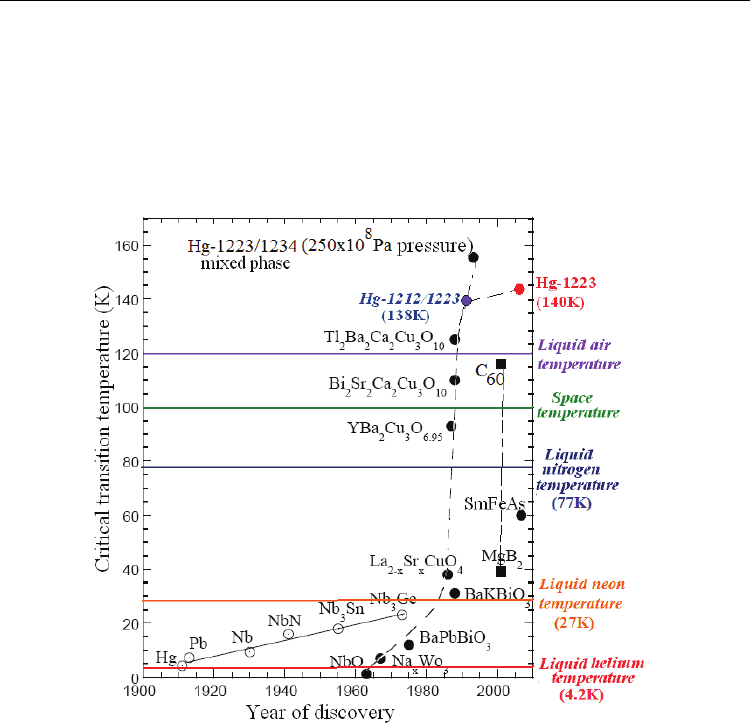
Superconductor
292
HgBa
2
Ca
2
Cu
3
O
8+x
superconductor (Gao et al., 1993). Ihara et al. also attained the T
c
=156K
by the application of 250.10
8
P pressure to the superconducting material contains both Hg–
1223 and Hg–1234 phases (Ihara et al., 1993). Afterwards, in 1996, Onbaşlı et al. achieved the
highest critical transition temperature of 138K at normal atmospheric pressure in the
optimally oxygen doped mercury cuprates which contain Hg-1212 /Hg-1223 mixed phases
(Onbaşlı et al., 1996). Recently, the new world record of T
c
at the normal atmospheric
pressure has been extended to 140K for the optimally oxygen doped mercury cuprate
superconductor by Onbaşlı et al. (Onbaşlı et al., 2009).
Fig. 1. Illustration of the years of discovery of some superconducting materials and their
critical transition temperatures.
In general, layered superconductors such as Bi-Sr-Ca-Cu-O, are considered as an alternating
layers of a superconducting and an insulating materials namely intrinsic Josephson junction
arrays (Helm et al., 1997; Ketterson & Song, 1999). As is known that Josephson junction
comprises two superconductors separated by a thin insulating layer and the Josephson
current crosses the insulating barrier by the quantum mechanical tunnelling process
(Josephson, 1962). The schematic representation of the superconducting-insulating-
superconducting layered structure is illustrated in Fig. 2.
In the Lawrence-Doniach model, it is assumed that infinitesimally thin superconducting
layers are coupled via superconducting order parameter tunnelling through the insulating
layers in layered superconductors (Lawrence & Doniach, 1971). Recent work on the
optimally oxygen doped mercury cuprate superconductors has shown that the Hg-1223
superconducting system is also considered as an array of nearly ideal, intrinsic Josephson
junctions which is placed in a weak external field along the c-axis (Özdemir et al., 2006).
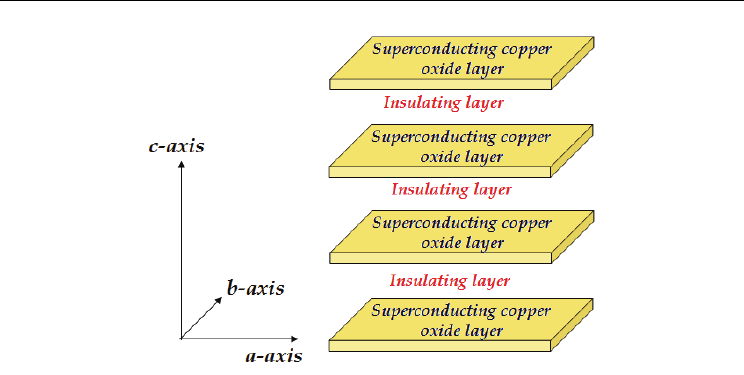
Superconductors and Quantum Gravity
293
Fig. 2. The schematic representation of the intrinsic Josephson structure in the layered high
temperature superconductors.
Moreover, the Hg-1223 superconducting system verifies the Interlayer theory, which expresses
the superconductivity in the copper oxide layered superconductors in terms of the occurrence
of the crossover from two-dimensional to three-dimensional coherent electron pair transport.
The realization of the three dimensional coherent electron pair transport can be achieved by
the Josephson-like or Lawrence-Doniach–like superconducting coupling between the
superconducting copper oxide layers (Anderson, 1997; Anderson, 1998). In other words, if the
Josephson coupling energy equals to superconducting condensation energy, the
superconducting system exhibits the perfect coupling along the c-axis (Anderson, 1998). With
respect to this point of view, we have analyzed the mercury cuprate system by comparing the
formation energy of superconductivity with the Josephson coupling energy and the equality of
these energies has been achieved at around the liquid helium temperature for the system
(Özdemir et al., 2006; Güven Özdemir et al., 2009).
Since the mercury cuprates justify the Interlayer theory at the vicinity of the liquid helium
temperature, the mercury cuprate Hg-1223 superconducting system acts as an
electromagnetic wave cavity (microwave and infrared) with the frequency range between
10
12
and 10
13
Hz depending on the temperature (Özdemir et al., 2006; Güven Özdemir et al.,
2007). Moreover, the optimally oxygen doped HgBa
2
Ca
2
Cu
3
O
8+x
(Hg-1223) superconductor
exhibits three-dimensional Bose-Einstein Condensation (BEC) via Josephson coupling at the
Josephson plasma resonance frequency at the vicinity of the liquid helium temperature
(4.2K-7K) (Güven Özdemir et al., 2007; Güven Özdemir et al., 2009). In this context, mercury
based superconductors have a great interest for both technological and theoretical
investigations due to the occurrence of intrinsic Josephson junction effects and the three
dimensional BEC. In this context, the mercury cuprate superconductors have a great
potential for the advanced and high sensitive technological applications due to their high
superconducting critical parameters, the occurrence of the intrinsic Josephson junction
effects and, the three dimensional BEC. Due to that reasons, the importance of the
determination of the concealed physical properties of the mercury cuprates becomes crucial.
To avow the fact, the effective mass of the quasi-particles, which describes the dynamics of
the condensed system, has been investigated in details in the following sections.

Superconductor
294
3. Derivation of the effective mass equation of quasi particles via order
parameter in the HgBa
2
Ca
2
Cu
3
O
8+x
mercury cuprate superconductors
In our previous works, the effective mass equation of quasi-particles in the mercury cuprate
superconductors has already been established by invoking an advanced analogy between
the supercurrent density J
s
, which depends on the Josephson penetration depth,
λ
J
, and the
third derivative of the phase of the quantum wave function of the superconducting
relativistic system (Aslan et al., 2007; Aslan Çataltepe et al., 2010). In this section, the logic of
the derivation process of the effective mass equation has been expressed in details.
Since the mercury cuprate system exhibits three dimensional BEC, the system is represented
by the unique symmetric wave function,
ψ
, and all quasi-particles occupy the same quantum
state. In this context, the superconducting state is represented by the superconducting order
parameter
1
,
ψ
, which is defined by the phase differences,
ϕ
between the superconducting
copper oxide layers of the system.
exp( )i
ψ
ψϕ
=
(1)
In this context, in order to derive the effective mass equation, our starting point is the
universally invariant parameter of
ϕ
by means of Ferrel & Prange equation (Ferrell &
Prange, 1963). As is known, the Ferrel & Prange equation (Eq. 2) predicts how the screening
magnetic field penetrates into parallel to the Josephson junction
2
22
1
sin
J
d
dx
ϕ
ϕ
λ
=
(2)
where
λ
J
is the Josephson penetration depth (Ferrell & Prange, 1963, Schmidt, 1997). The
Josephson penetration depth represents the penetration of the magnetic field induced by the
supercurrent flowing in the superconductor
2
. The Josephson penetration depth is defined as
0
2
8
J
c
c
Jd
φ
λ
π
= (3)
where, c is the speed of light, J
c
is the magnetic critical current density,
φ
0
is the magnetic
flux quantum, and d is the average distance between the copper oxide layers. The solution
of the Ferrel & Prange equation gives the phase difference distribution over the junction. If
the external magnetic field is very weak, both the current through the Josephson junction
and the phase difference become small. In these conditions, the Ferrel & Prange equation
has an exponential solution as given in Eq. (4) (Schmidt, 1997; Fossheim & Sudbo, 2004)
()
0
exp
J
x
x
ϕϕ
λ
⎛⎞
=−
⎜⎟
⎜⎟
⎝⎠
(4)
1
The superconducting order parameter, ψ is the hallmark of the phenomenological Ginzburg & Landau
theory that describes the superconductivity by means of free energy function.
2
The italic and bold representation intends to prevent the confusion from the concept of London
penetration depth.

Superconductors and Quantum Gravity
295
where φ
0
is phase value at x=0. Eq. (4) represents the invariant quantity of the phase of the
quantum system, φ, as a function of distance, x for low magnetic fields (lower than H
c1
)
(Fig. 3(b)-1).
According to Schmidt, the first and second derivatives with respect to distance correspond
to the magnetic field, H(x) at any point of the Josephson junction and the supercurrent
density, J
s
, respectively (Schmidt, 1997). The related H(x)=f(x) and J
s
=f(x) graphics for low
magnetic fields are illustrated in Fig. 3(b)-2 and 3, respectively. Since the supercurrent
density, J
s
, is related to the velocity of the quasi-particles, we have made an analogy between
the velocity versus wave vector schema and the super current density versus distance
schema in Fig. 3. As is known in condensed matter physics, the effective mass of the quasi-
particles is derived from the first derivative of the velocity with respect to wave vector. Like
this process, the effective mass of the quasi-particles in the mercury cuprate
superconductors can be determined by the first derivative of the J
s
with respect to distance
x. From this point of view, in order to achieve the effective mass of the quasi-particles, the
first derivative of the supercurrent with respect to distance has been taken. The first
derivative of the supercurrent density,
s
dJ
dx
, is proportional to third derivative of the phase,
3
3
()dx
dx
ϕ
.
()
3
3
00
0
23 2
1
exp
88
s
J
J
dx
dJ c c x
dx d dx d
ϕ
φφ
ϕ
π
πλ λ
⎛⎞ ⎛⎞
==−−
⎜⎟ ⎜⎟
⎜⎟ ⎜⎟
⎝⎠ ⎝⎠
(5)
Consequently, we have calculated the inverse values of m* via the first derivative of the
supercurrent density of the system.
3
0
*2
0
11
exp
8
JJ
cx
md
φ
ϕ
πλ λ
⎛⎞ ⎛⎞
=− −
⎜⎟ ⎜⎟
⎜⎟ ⎜⎟
⎝⎠ ⎝⎠
(6)
We have called Eq. (6) as “Ongüas Equation” that gives the relationship between the m* and
the phase of the superconducting state (Aslan et al., 2007; Aslan Çataltepe et al., 2010). This
effective mass equation also confirms the suggestion, proposed by P.W. Anderson, that the
effective mass is expected to scale like the reverse of the supercurrent density (Anderson,
1997). The derivation of the effective mass equation are summarized in Fig. 3.
Let us examine the signification of the effective mass determined by the Ongüas Equation.
As is known, the effective mass of the quasi-particles is classified as the in-plane (m
ab
*) and
out off-plane (m
c
*) effective masses in the anisotropic layered superconductors, like mercury
cuprates (Tinkham, 1996). On the other hand, as the mercury cuprate superconducting
system is represented by a single bosonic quantum state due to the occurrence of the spatial
i.e. three dimensional Bose-Einstein condensation, there is no need to consider the in-plane
(m
ab
*) and out off-plane (m
c
*) effective masses, one by one . In this context, the effective mass
of the quasi-particles, m*, calculated by the Eq. (6), is interpreted as the
“net effective mass
of the quasi-particles”
for the superconductor which exhibits the spatial resonance. Hence,
the quasi-particles, described by the net effective mass, cannot be attributed to the
Bogoliubov quasi-particles in the Bardeen-Cooper-Schrieffer (BCS) state. We have proposed
that the generation of the mentioned net effective mass of the quasi-particles is directly
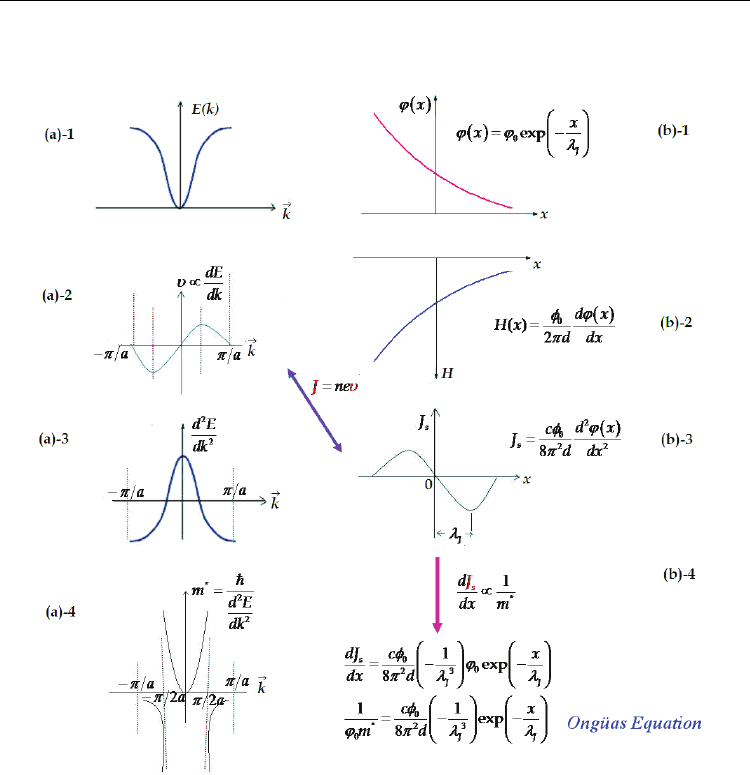
Superconductor
296
related to the Higgs mechanism in the superconductors, which will be discussed in Section
5. (Higgs, 1964 (a), (b)).
Fig. 3. The derivation procedure of the effective mass equation of the quasi-particles in the
condensed matter physics and the mercury cuprates are given in (a)-1,2,3,4 and (b)-1,2,3,4,
respectively. (b)-1 The phase versus length graphic for the low magnetic fields in the
Josephson junction. (b)-2 The distance dependence of the magnetic field in the Josephson
junction. (b)-3 The super current in the Josephson junction versus distance graph. (b)-4 The
effective mass equation of the quasi-particles has been derived from the relation of the
supercurrent density versus distance.
4. The net effective mass of the quasi particles in the optimally and over
oxygen doped mercury cuprate superconductors
In our previous works, the effect of the rate of the oxygen doping on the mercury cuprates
has been investigated in the context of both the superconducting critical parameters, such as
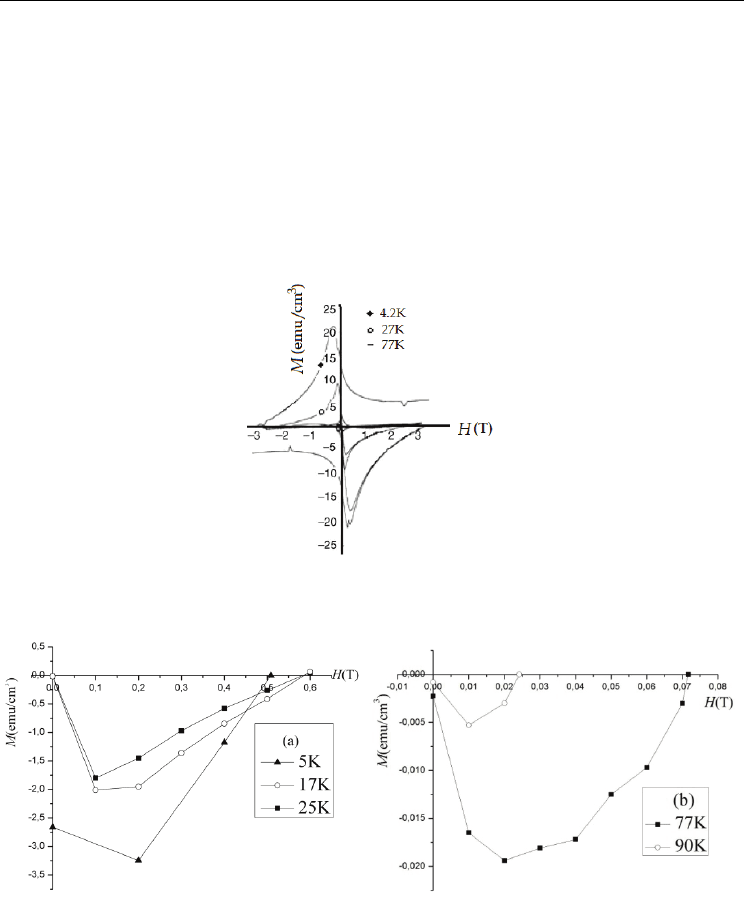
Superconductors and Quantum Gravity
297
the Meissner critical transition temperature, lower and upper critical magnetic fields, critical
current density and the electrodynamics parameters by means of Josephson coupling
energy, Josephson penetration depth, anisotropy factor etc. In this section, the effect of the
oxygen doping on the effective mass of the quasi-particles has been examined on both the
optimally and over oxygen doped mercury cuprates from the same batch. The net effective
mass values have been calculated via the magnetization versus magnetic field experimental
data obtained by the SQUID magnetometer, Model MPMS-5S. During the SQUID
measurements, the magnetic field of 1 Gauss was applied parallel to the c-axis of the
superconductors and the critical currents flowed in the ab-plane of the sample. The magnetic
hysterezis curves for the optimally and over oxygen doped Hg-1223 superconductors at
various temperatures are given in Fig. 4 and Fig. 5, respectively.
Fig. 4. The magnetization versus applied magnetic field curves of the optimally oxygen
doped mercury cuprates at 4.2, 27 and 77K (Özdemir et al., 2006).
Fig. 5. The magnetization versus applied magnetic field of the over oxygen doped mercury
cuprates at 5, 17, 25, 77 and, 90K are seen in Figure 5(a) and (b), respectively. (Aslan
Çataltepe, 2010).
According to the Bean critical state model, the critical current densities of the Hg-1223
superconductors have been calculated at the lower critical magnetic field of, H
c1
(Bean, 1962;
Bean, 1964). In this context, the system does not have any vortex. The magnetization
difference between the increasing and decreasing field branches, ∆M, has been extracted
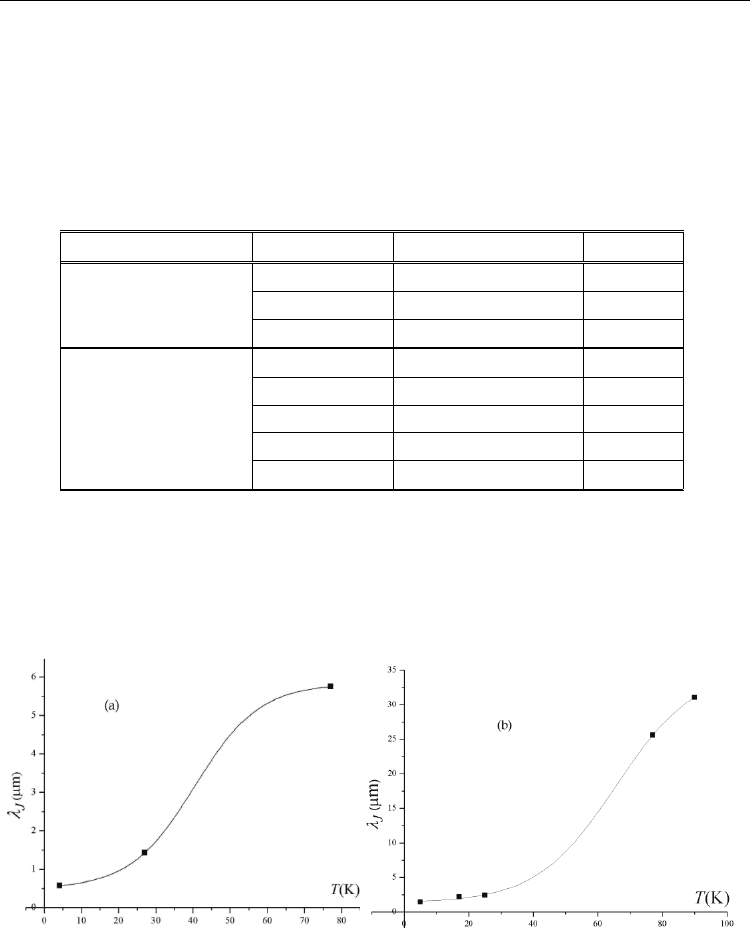
Superconductor
298
from magnetization versus magnetic field curves and the average grain size of the sample
has been taken as 1.5
μ
m (Onbaşlı, 1998). The Josephson penetration depth values, which
have a crucial role in determining the net effective mass, have been calculated by Eq. (3). In
Eq. (3), the average distance between the superconducting layers, d, has been obtained by
XRD data that reveals to 7.887x10
-10
m (Özdemir et al., 2006).
The critical current densities (J
c
) have been calculated at the lower critical magnetic field and
the corresponding Josephson penetration depths are given in Table 1 for the optimally and
over oxygen doped Hg-1223 superconductors (Özdemir et al., 2006; Güven Özdemir, 2007).
Material Temperature (K) J
c
(A/m
2
) at H
c1
λ
J
(
μ
m)
4.2 1.00x10
12
0.575
27 1.62x10
11
1.430
Optimally oxygen
doped Hg-1223
superconductor
77 1.00x10
10
5.75
5 1.58x10
11
1.449
17 6.88x10
10
2.195
25 5.71x10
10
2.410
77 5.07x10
8
25.581
Over oxygen doped
Hg-1223
superconductor
90 3.44x10
8
31.055
Table 1. The critical current density and Josephson penetration depth values for the
optimally and over oxygen doped mercury cuprates.
Variations of the Josephson penetration depth with temperature for the optimally and over
oxygen doped Hg-1223 superconductors have been obtained by the Origin Lab 8.0®
program (Fig. 6-(a) and (b)).
Fig. 6. The temperature dependence of the Josephson penetration for (a) the optimally (b)
the over oxygen doped Hg-1223 superconductors.
The temperature dependences of the Josephson penetration depth for the optimally and
over doped samples both satisfy the Boltzmann equations which are given in Eqs. (7-a) and
(7-b), respectively.
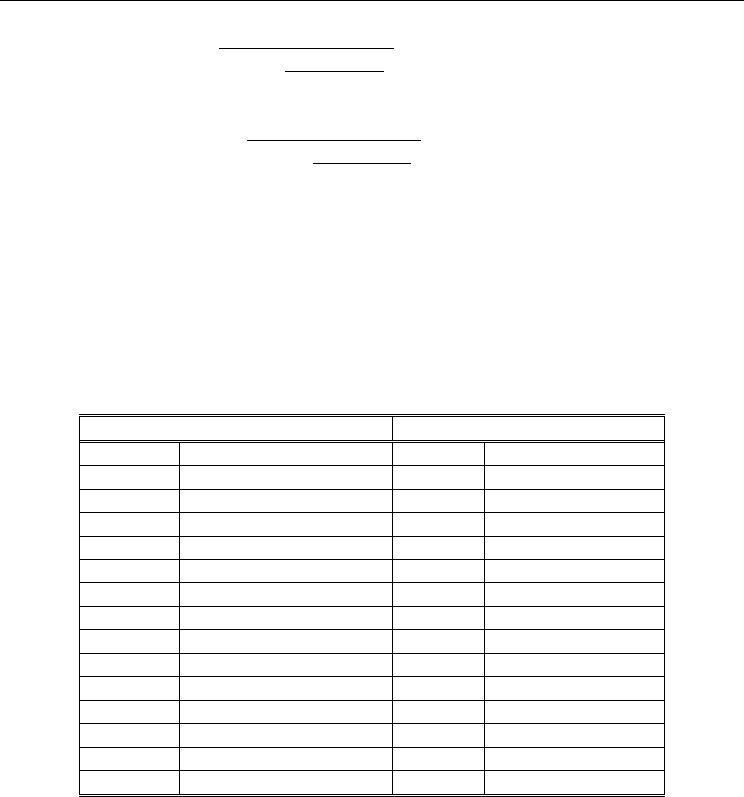
Superconductors and Quantum Gravity
299
()
(
)
0.49346 5.82915
5.82915 for the optimall
y
doped H
g
-1223
40.46878
1exp
8.70652
J
m
T
λμ
−
=+
−
⎛⎞
+
⎜⎟
⎝⎠
(7a)
()
(
)
1.33383 35.08815
35.08815 for the over doped H
g
-1223
65.54345
1exp
12.24175
J
m
T
λμ
−
=+
−
⎛⎞
+
⎜⎟
⎝⎠
(7b)
In addition to experimental data, some
λ
J
values for various temperatures have been
calculated by using Eqs. (7-a) and (7-b).
The net effective mass values for the optimally and over oxygen doped superconductors
have been calculated by Eq. (6). The phase value at x=0 has been taken as a constant
parameter in all calculations. In order to investigate the temperature dependence of the net
effective mass, the distance parameter, x in Eq. (6) has been chosen as 0.3
μ
m which is
smaller than the lowest
λ
J
values for both the optimally and over oxygen doped samples.
The net effective mass values for the optimally and over oxygen doped Hg-1223
superconductors are given in Table 2.
The optimally oxygen doped Hg-1223 The over oxygen doped Hg-1223
T(K) m* (kg) T(K) m* (kg)
4.2 -3.20x10
-20
5 -3.76x10
-19
10 -4.35x10
-20
10 -5.79x10
-19
17 -8.24x10
-20
17 -1.21x10
-18
20 -1.20x10
-19
20 -1.20x10
-18
25 -2.57x10
-19
25 -1.59x10
-18
27 -3.76x10
-19
27 -2.26x10
-18
30 -6.14x10
-19
30 -3.26x10
-18
40 -3.26x10
-18
40 -1.38x10
-17
50 -9.72x10
-18
50 -6.92x10
-17
60 -1.596x10
-17
60 -3.09x10
-16
70 -1.91x10
-17
70 -9.76x10
-16
77 -2.00x10
-17
77 -1.70x10
-15
90 -2.07x10
-17
90 -3.03x10
-15
100 -2.08x10
-17
100 -3.70x10
-15
Table 2. The net effective mass values for the optimally and over oxygen doped mercury
cuprates.
According to the data in Table 2, the temperature dependences of the net effective mass of
the quasi-particles for the optimally and over oxygen doped mercury cuprates from the
same batch both satisfy Boltzmann fitting (Fig. 7 and Fig. 8).
5. The relativistic interpretation of the net effective mass
In this section, we have developed a relativistic interpretation of the net effective mass of the
quasi-particles in the mercury cuprate superconductors. Let us review the origin of mass in
the context of Higgs mechanism to construct a relativistic bridge between condensed matter
and high energy physics.

Superconductor
300
Fig. 7. The m* versus temperature for the optimally O
2
doped Hg-1223 superconductor.
Fig. 8. The m* versus temperature for the over O
2
doped Hg-1223 superconductor.
As is known, the superconducting phase transition generally offers an instructive model for
the electroweak symmetry breaking. The weak force bosons of W
±
and Z
0
become massive
when the electroweak symmetry is broken. This phenomenon is known as the Higgs
mechanism which can be considered as the relativistic generalization of the Ginzburg-
Landau theory of superconductivity (Ginzburg & Landau, 1950; Higgs (a),(b), 1964; Englert
& Brout, 1964; Guralnik et al., 1964; Higgs, 1966; Kibble, 1967; Quigg, 2007).
Y. Nambu, who
was awarded a Nobel Prize in physics in 2008
for his valuable works on spontaneous
symmetry breakings in the particle physics, had also stated that “the plasma and Meissner
effect” had already established the general mechanism of the mass generation for the
